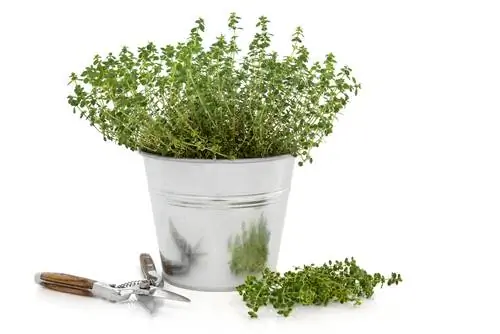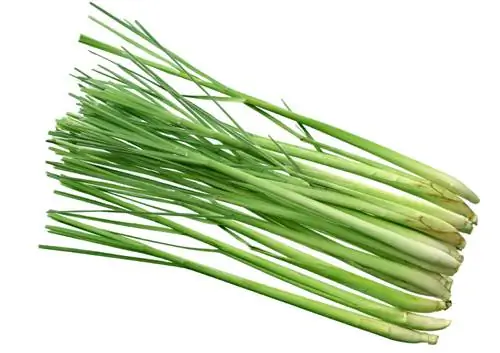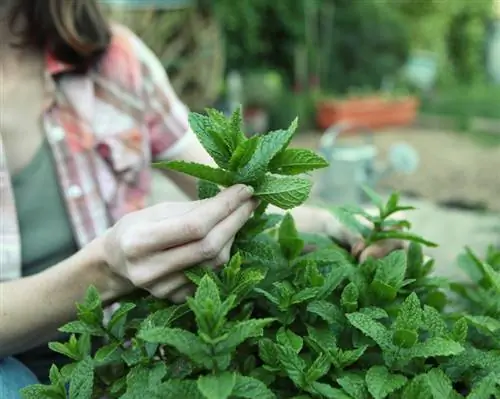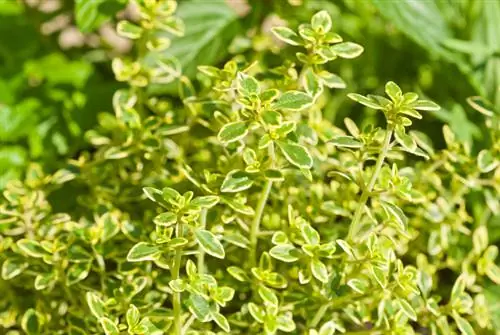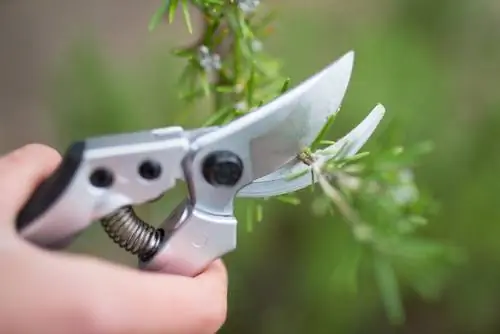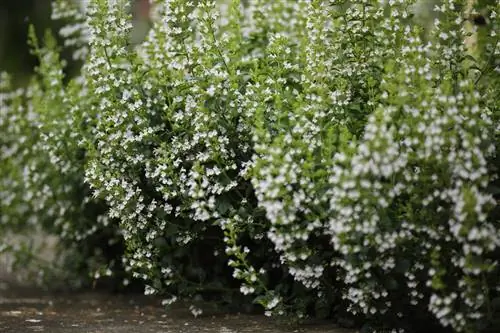- Author admin [email protected].
- Public 2023-12-16 16:46.
- Last modified 2025-01-23 11:21.
Thyme only seems to thrive as an herbaceous perennial. In reality, there is a steady growth of woody growth from the base. Harvesting alone does not prevent unwanted requests. Only annual pruning maintains the premium quality of the Mediterranean aroma artist. Read here when and how to cut thyme correctly.
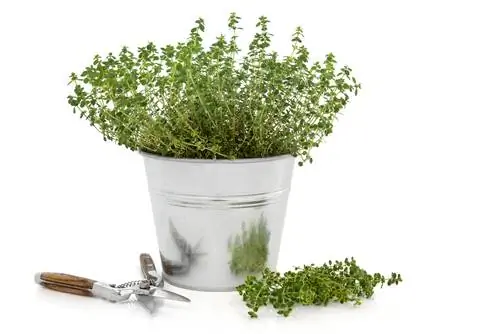
How and when should you cut thyme?
To prune thyme properly, perform a planting pruning in spring for compact growth and an annual maintenance pruning to counteract woodiness. If thyme is neglected, rejuvenation pruning is recommended in February or March. Always cut in the leafy area.
Cutting types and dates
In addition to regular harvesting, you should subject your thyme to maintenance pruning. A simple plant cut ensures compact, richly branched growth. Without a cut, woodiness and baldness gain the upper hand, which gives rise to a rejuvenation cut. This overview summarizes all the important types of cutting for a premium quality thyme:
| Cut style | Goal/Occasion | best date |
|---|---|---|
| Plant cutting | compact growth, rich branching | in spring after planting |
| Conservation cut | Lignification containment, continuous rejuvenation | Spring or Summer |
| Rejuvenation cut | revitalizing neglected thyme | End of February to beginning of March |
Pruning stimulates branching
With one plant cut, you can direct thyme into the desired growth form as a compact, lushly branched herb plant. It is mainly small, weak young plants that benefit from the tried and tested method of cutting. The best time for the prologue in pruning care is between March and May. This applies regardless of whether you decided to plant in fall or spring. How to do it right:
- Remove damaged or frozen shoots at the beginning
- In the next step, cut back all shoots by a third or half
- Rule of thumb: the weaker a shoot, the harder it is cut
If thyme finds its way into your garden as a strong young plant, you can reduce the amount of pruning to trimming. No scissors are required for this. Hold the tip of a shoot above the next pair of promising leaves between your thumb and forefinger and snap off the herbaceous piece. Plant pruning or pruning is at the expense of the first flowering period. The reward for the little effort is a stable, lush branching.
Tip
If the planting is cut before the ice saints in mid-May, protect your young thyme from delayed ground frosts with fleece. If meteorologists predict nighttime temperatures below freezing, throw the warm, breathable cover over the young plant. During the day, the little sun worshiper should not remain covered.
Pruning prevents lignification
For thyme to meet high expectations, it is not enough if you cut the plant in conjunction with harvesting. Only annual maintenance pruning prevents progressive lignification, promotes the growth of aromatic annual shoots and guarantees the advantageous hemispherical growth habit. The best time is in spring. If you miss this date, cut the Mediterranean herb plant after the flowering period. This is how it works:
- Sharpen scissors, clean with hot water and disinfect with alcohol
- Cut back the shoots all around by one to two thirds
- Leave the shoots a little higher in the center to create a hemispherical shape
- Care: always cut in the leafy area
Do you care for flowering thyme without using it as a culinary herb? Then cut off faded flowers after the main flowering period. If the weather conditions are suitable and in a sunny location, the Mediterranean beauty will put on its flower dress again. After the second flowering, there is no further pruning so that the plant matures reliably before winter and is prepared for frost.
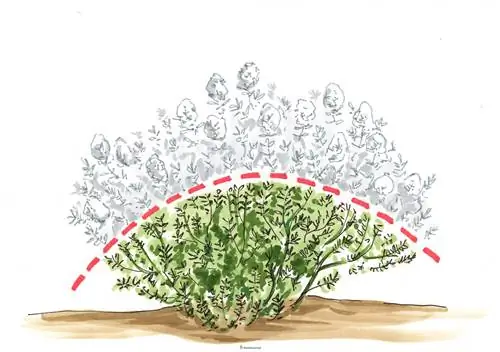
Cut back thyme by up to two-thirds each spring. Avoid cutting the wood. The hemispherical shape ensures light-flooded, richly leafy growth.
Excursus
Cut thyme with rose scissors
With delicate flowers and aromatic decorative leaves, thyme harmonizes wonderfully with roses. If you decide on the decorative duo, simply use the rose scissors for both garden beauties. Rose scissors have all the qualities that are valuable for maintaining thyme. The special scissors can even easily thin out heavily woody shoots. It is important to note when purchasing that they are designed as bypass scissors with two sharp cutting edges.
Rejuvenate old thyme
If thyme pruning care is limited to occasional harvesting, massive lignification of the shoots is inevitable. This is no reason to clear a well-established plant. As long as thyme has leafy, herbaceous areas, a rejuvenating cut can solve the problem. How to properly revitalize thyme in the bed and pot:
- The best time is the end of February/beginning of March in mild, overcast weather
- Hold a woody shoot with a heavily branched, leafy head and bend it to the side
- Place the scissors in the leafy area, as close as possible to the beginning of the bare woody area
- Cut every single ground shoot in this way
Fully woody and dead branches should be thinned out at the base. Ideally, look for a hemispherical shape for light-flooded growth. With a little luck, the radical cut will elicit fresh shoots from the rootstock to rebuild the subshrub. Then apply an organic fertilizer that supports revitalization.
Background
Never cut shrubs into the wood
Thyme thrives as a Mediterranean subshrub with a woody base and herbaceous annual shoots. This means that pruning care is on par with magnificent lavender and spicy rosemary. The floral ambassadors from the Mediterranean forego the creation of sleeping eyes along the woody parts. If you make a cut outside the leafy area, you will look in vain for fresh shoots. Regular cutting prevents progressive woodiness and promotes the longed-for, herbaceous shoots and spicy leaves.
Frequently asked questions
Is thyme hardy?
The most popular types of thyme are all reliably frost-resistant, provided the location is sufficiently sunny and well-drained. These include real thyme (Thymus vulgaris), scented thyme (Thymus odoratissimus), cushion thyme (Thymus doerfleri) and field thyme (Thymus pulegioides). Sand thyme is the heartiest type with winter hardiness of up to -30 degrees. The winter hardiness of lemon thyme (Thymus citriodorus) is limited. The garden treasure cannot survive in the bed without extensive winter protection. A frost-free winter quarter in the pot is strongly recommended.
When is the best time to harvest thyme?
Shortly before the flowering period begins, the sap pressure in all herb plants pulsates at maximum level. At this time the aroma content of the leaves is also at its peak. Thyme lovers prefer to harvest whole shoots just before the flowers open. The best time of day to cut the crop is late morning when the morning dew has evaporated. What the kitchen cannot use freshly harvested is dried upside down in a small, airy place.
I care for real thyme in the balcony box. Can the herb plant overwinter outside?
Thyme is naturally winter-hardy in our regions when it thrives in beds. However, in the limited substrate volume of a balcony box, the Mediterranean plant is vulnerable to severe frost. Equipped with a winter coat made of jute, foil or garden fleece, thyme can overwinter outside. However, harvesting is usually not possible. If you want to continue harvesting, move the box to the windowsill, for example in the kitchen.
Dwarf thyme 'Minor' thrives as a ground cover in my rock garden. Is this variety edible?
As long as consumption is limited, dwarf thyme is not poisonous. The variety does not come close to the aromatic flavor of real thyme. With a growth height of 5 to 10 centimeters, there is hardly any material available for use as a culinary herb. The primary goal in breeding was a decorative function as a widespread flowering and fragrant shrub.
Does Thymus vulgaris form runners? Should I plant the plant with a root barrier to prevent it from spreading throughout the garden?
Primarily real thyme and all varieties derived from it tend to form runners. For this reason, the herb plant is often used as a decorative ground cover in rock gardens and on dry stone walls. Where spreading is not desired, we recommend lining the planting pit with a root barrier.
Our thyme bloomed magnificently in the garden for four years. Recently the plant seems to be dying in the middle. What to do?
Many thyme species tend to have dense growth in the center. The high pressure causes the plant to go bald at this point. A division solves the problem. In spring, dig up the root ball over a large area. Divide the plant in half or even more parts. Take this opportunity to cut off any bare, compacted areas. Then plant the root ball pieces at the current or new location.
The 3 most common cutting mistakes
Thyme has an aversion to cutting into the wood or in late autumn. In the worst case, the Mediterranean herb plant reacts to these cardinal errors in pruning care with complete failure. The following list lists common cutting errors by name with recommendations for skillful prevention:
| Cutting errors | malicious image | Prevention |
|---|---|---|
| cut into wood | sparse growth or total failure | Always cut thyme in the leafy area |
| Bedding thyme radically blended in autumn | massive frost damage | Rejuvenate bedding varieties in spring |
| never cut | premature lignification, declining crop yield | cut back heavily once a year |

Tip
Air is the ideal preservation medium for thyme in the bed and lemon thyme in the pot. Shortly before the flowering period begins, cut off a whole bunch of the aromatic shoots and bundle the harvest into small bouquets. Hung upside down in the dark, airy attic, the stems and leaves dry within 8 to 10 days.

